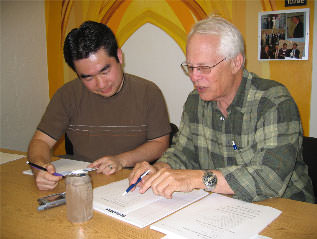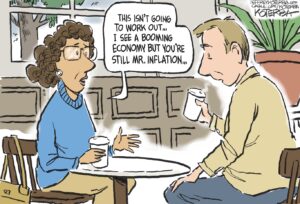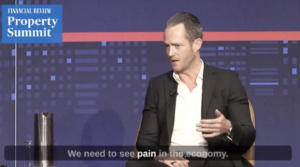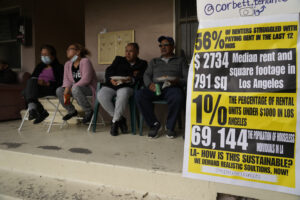Taking Back Our Schools–and Fixing Them
The director of the Education Leadership Program at UCLA forcefully argues that public education funds must be diverted from bloated bureaucracies and redirected into the schools, where principals, teachers and parents can meaningfully influence what is being taught.
Editor’s Note: In the following essay, Wellford “Buzz” Wilms, The director of the Education Leadership Program at UCLA forcefully argues that public education funds must be diverted from bloated bureaucracies and redirected into the schools, where principals, teachers and parents can meaningfully influence what is being taught.
The recent news reported in The New York Times that schools are throwing out science, social studies and art to make time for drilling students in remedial math and reading is a sign of things gone terribly wrong. Former New York State Commissioner of Education Thomas Sobol told the Times that narrowing education to just math and reading would be akin to restricting violin students to playing scales day after day. “They’d lose their zest for music.” But most schools that serve poor populations, like those in Cuero, Texas, are squeezed to meet federal math and reading standards. Cuero Superintendent Henry Lind told the paper, “When you have so many hours per day and you’re behind in some area that’s being hammered on, you have to work on that.”
But by the looks of things, hammering students for higher test scores isn’t making much of a difference. Most students have already lost their zest for learning. How do we know? In Los Angeles, upwards of 50% of Latino and African American students never finish high school. This is just the tip of the iceberg.
I’ve been a professor of education at UCLA for more than 25 years and am convinced that despite the fads that come and go, nothing has put a dent in the public schools’ failure to educate inner-city children. In fact, things are getting worse. But I am also convinced that we’ve been looking in the wrong places for solutions. My own research across a wide array of organizations — corporations, trade unions, public schools, colleges, teacher unions and police agencies — suggests another way of looking at the problem and that solutions will come from a new direction.
This essay is a proposition — one that I hope will spark a lively debate among Truthdig readers and inform policy leaders. Future essays will examine Los Angeles Mayor Antonio Villaraigosa’s campaign to take over the public schools, analyze whether teacher unions can be a force for productive change, and expose promising ways to rebuild public investment in the schools.
Let’s start with Jonathan Kozol’s new book, “The Shame of the Nation: The Restoration of Apartheid Schooling in America.” It is a scathing indictment of American social policy that banned racial segregation in public schools in 1955 and then turned a blind eye to its implementation. Today, Kozol says, schools are more segregated than ever. But he fails to explain why resegregation has occurred. Because Kozol overlooks the root causes of the problem, his solutions — spending more money on dysfunctional schools and wishing for a social mandate to desegregate the schools — miss the point.
To be sure the problems are undeniable. Kozol examines the appalling condition of big-city schools. In school after school we see children who are brimming with potential but who are walled off from the larger society and abandoned by the schools. Most middle-class white Americans simply cannot comprehend the horrid schools that Kozol describes. Ceilings fall in, toilets are filthy, libraries, music and arts have been stripped away. Teachers in these schools, who are paid 40% less than teachers in the suburbs, are forced to teach “scripted” lessons that are written for children who are deemed incapable of learning.
It is all part of the latest reform pushed by the Bush administration’s No Child Left Behind initiative, a reform aimed at the singular pursuit of increasing test scores. Learning has been stripped of its intrinsic meaning and reduced to simplistic steps — “Authentic Writing,” “Active Listening,” “Accountable Talk” — that hamper teachers in teaching anything but how to take a test. Behind it all is an attempt to impose control, much as mass production techniques were used a century ago, to standardize instruction to fit new immigrants to the system.
Meanwhile, millions of children are failing. In nearly half of the high schools in America’s 100 largest districts, fewer than 50% of students graduate in four years. Most of these students are from poor Latino and African-American families. And from 1993 to 2000 the number of failing schools has mushroomed by 75%. Mayor Villaraigosa calls Los Angeles’ high dropout rates “numbers that should put a chill down your spine.”
The reasons, Kozol argues, are lack of money and racial discrimination that produce inferior and segregated schools. No doubt this is partly true. We have tried to desegregate the schools for a half-century and failed. Middle-class white parents have voted for individual freedom with their feet, enrolling their children in private schools, leaving the public schools more segregated than ever. The same is true for middle-class black families. Gail Foster, an educator who has studied black independent schools, was quoted in 2004 in The New York Times as saying: “Many of the most empowered parents and families are removing their children. What’s left, in even working-class communities, are schools filled with the least empowered families. Families with the least parent involvement to offer, families with the least help with homework to offer. There’s been a continual outflow for at least 10 years, and it isn’t stopping now.”
More money is not the answer either. Kozol points to wide disparities in educational expenditures ranging from $11,700 per student in New York City to $22,000 in suburban Manhasset. Disturbing as that is, study after study shows that equalizing money does not necessarily equalize learning.
In 1966, sociologist James Coleman conducted the most extensive study ever made of desegregating education and found that what mattered most in students’ learning was the economic status of their peers rather than the racial makeup of the school. He also found that school funding was not closely related to students’ achievement — their families’ economic status was far more predictive. Coleman’s findings were controversial and led to a bitter debate, but they have been replicated many times. Daniel Patrick Moynihan summed it up best when he commented shortly after Coleman’s groundbreaking study, “We should begin to see that the underlying reality is not race but social class.”
Since social class matters because money follows privilege, and since desegregation will take generations to eradicate, what can be done now? Are poor children doomed to attend grossly inadequate schools? Surely not. We must find ways to remove the influences that have crippled the schools. Money must be diverted from bloated bureaucracies that snuff out innovation. Instead it must go directly to schools where principals and teachers can influence what is taught and what children learn, and help bring parents back into the fold. Otherwise, it is going down a rat hole.Parents have a significant role to play in their children’s education, but their voices have been largely silenced. Over the last 40 years, we have witnessed the decline of civic involvement and the growing dominance of self-interest over the greater good, a social deterioration that sociologist Robert Putnam calls “hollowing out” in his 2000 book “Bowling Alone.” One result, as the old saying goes, is that “the rich get richer” and the poor fall ever further behind in crumbling schools.
Over the last 25 years, education in general has been taken from ordinary citizens and teachers by politicians, administrators, union leaders, publishers, test makers, consultants, university professors, hardware and software developers and the media, each playing its part in keeping alive the illusion of reform. All in all, this $1-trillion industry has replaced the common interest, and no one, it seems, can muster the will to rein it in.
Local control is only a dim memory. Decisions now come from the top — from the federal and state governments, school boards and high-level administrators who have little knowledge of what goes on in the classroom. Teachers are left out of these decisions, carrying on the best they can, safe in the assumption that the newest fad, like those before it, will blow over. Parents are all but forgotten.
While command-and-control management may seem to produce results in the short run, it strips schools of the capacity to develop the stable leadership that is necessary to sustain success. Principals are besieged with demands from district offices and from the educational fads that emanate from publishers and university researchers. Many principals know that they put their careers in peril unless they do what their bosses want. One elementary school principal told me, “District directives undermine our own abilities to think for ourselves, to believe in what we see and know.” When schools discover something that works, it is rarely sustained because they lack authority or stable leadership.
In 1969 when I worked for the U.S. Department of Health, Education and Welfare, I monitored the schools in impoverished Ocean Hill-Brownsville in New York City. The local school board hired a charismatic superintendent, who fired incompetent teachers and hired young and idealistic ones. The firings set the local board at odds with the huge teachers’ union, which demanded due process for the fired teachers. The superintendent, Rhody McCoy, was convinced that good teachers had to respect the children they taught. He put it in plain words: “If you’re convinced that this kid is doomed by nature or by something else to lead a shrunken and curtailed life, then you’re basically incompetent to teach that child.” The experiment worked. Observing classrooms left no doubt in my mind that students were learning. Eager first-graders sat attentively on the floor in semicircles shouting out answers to fraction problems and reading aloud. The schools buzzed with excitement as parent helpers streamed in and out of classrooms. But in a bitter power struggle the board seized authority and the experiment ended.
Years later, in 1985, Deborah Meier, a passionate educator who founded Harlem’s Central Park East Secondary School, achieved stunning successes that led the school to be celebrated as a model alternative school in Time magazine. But it could not be sustained beyond Meier’s unique leadership. Today, 10 years after Meier left, a respected children’s advocacy group, Insideschools and Advocates for Children, reports that the Harlem school “…has fallen on hard times in recent years with rapid staff turnover, low staff morale and uneven discipline.”
In risk-averse environments like public schools, few principals will stick out their necks, because they don’t want to buck the bosses downtown. Courageous and visionary principals like Rhody McCoy and Deborah Meier keep coming. But charismatic leadership is no match for heavy-handed district management, which always wins out.
Take Foshay Learning Center in Los Angeles, for example. In 1989, Howard Lappin took over a failing middle school. With the help of teachers and an infusion of money, Lappin wrested control from the district and transformed Foshay. The school expanded into a K-12 “learning center” and became largely autonomous of the district’s bureaucratic requirements. Teachers and administrators decided who would be hired and what would be taught. Foshay succeeded, and in 2000 its high school was selected by Newsweek as one of the 100 best in America. But in 2001 Lappin retired, and his unique leadership was lost. Today Foshay is being threatened with sanctions by the district and the county because gains in students’ test scores have stalled. As the school has fallen under the district’s “one-size-fits all” bureaucratic requirements, the impact has been to undermine the once vibrant teacher leadership that made the school so enviable.
The problem with public education is not with the teachers, or with the children, but the way we organize the schools. Probably the greatest casualties are teachers themselves, who are forced to accept decisions by authorities about teaching that they know to be nonsense. One professor interviewed by Kozol said that forcing an absurdity on teachers teaches something: acquiescence. For example, in study after study, teachers report that relying on test scores as sole marks of student achievement and teaching scripted lessons destroy students’ natural love of learning. And such practices also erode teachers’ professional authority, which is fundamental to student learning.
Why is it so hard to foster the only kind of reform that really works, which is right in the schoolhouse? Because politicians, school board members and administrators are under intense pressure to produce immediate results, i.e., higher and higher test scores — a goal that is pursued through directives from districts with little input of principals, teachers and parents. Superintendents serve at the pleasure of school boards, and most board members are elected or appointed and have limited terms of office. As test scores have become the measure of educational quality, everyone is under immense pressure to show fast results or be turned out.
No wonder that school boards hire superintendents who promise to deliver quick results. But few do. Superintendents last on average only three or four years. Many are thwarted by outmoded bureaucracies that were designed a century ago using top-down control practiced in American industry to mass-produce learning. Within these organizations, power has quietly accumulated, making them all but impervious to outside influence. Sid Thompson, former superintendent of the Los Angeles Unified School District, told me: “Trying to change the district is like trying to change the direction of a fast-moving freight train. You might knock it off course for a moment, but before you know it it’s rattling right down the tracks again.” Frustration and suspicion about who might emerge from the shadows to sabotage their plans often lead superintendents to jealously guard their power. In 2002, Day Higuchi, then president of United Teachers Los Angeles, the Los Angeles teacher union, had high hopes for working with the school district’s new “can-do” superintendent, Roy Romer. Higuchi hoped that Romer would endorse a new union initiative called Lesson Study, a plan to help teachers work collectively to improve classroom lessons. At a breakfast meeting that I attended, Higuchi presented Romer with an invitation to work with the union to develop and spread Lesson Study across the district. When Higuchi finished, Romer flipped over his paper placemat and with a red felt pen drew a box with an S in it. “That’s me,” he said. Beneath he drew 11 boxes with smaller s’s in them, representing the 11 local superintendents, and below that, a number of small boxes with roofs, representing schools and teachers. Then, pulling his face near to Higuchi’s, he drew bold red arrows pointing downward from the top. Romer jabbed his pen in the air to accentuate each word: “You cannot usurp my authority to manage this district!” It was a dumbfounding moment, one that revealed the true underside of the use of power. Here was a chance for a new superintendent to forge a small but significant step with the union, but Romer, who recently announced his resignation, explained that he was “in a hurry.” He clearly had little time for ideas that were at odds with his own. In the end his refusal to work with the union undermined the possibility of creating a broader base of power that could transcend self-interest.
Nor are the unions exempt from self-interest. A few years ago I helped establish a national group of union presidents called TURN (Teacher Union Reform Network) who were dedicated to remaking their unions as forces to improve education. One way was to cooperate with administrators and encourage teachers to use their classroom know-how to redesign teaching at the schoolhouse. But hostility and mistrust run deep. The union leaders became nervous, fearing that fellow unionists would attack them for “collaborating” with the enemy and that if the effort to collaborate failed they would share the blame. Don Watley, president of the New Mexico Federation of Educational Employees, commented: “It’s like the Normandy landing. We’ve got the best troops in the world. We’ve got the best officers in the world. And we’ve got the best equipment in the world. But at 0800 when we hit the beach half of us are going to get killed!” Sadly, in the years to come, the ingrained mistrust, and the unpredictable dance of union politics, prevented these unionists from becoming a positive force in educational reform. Instead, they have been reduced to stockpiling power, much as the Soviets and Americans stockpiled nuclear weapons during the Cold War, to oppose any hostile moves the other side might make.
So what can be done to break the standoff between teacher unions and districts? How can teachers’ professional authority be restored? How can parents be awakened and brought back into the fold? Experience shows that it can be done. Schools such as Harlem’s Central Park East Secondary, Los Angeles’ Foshay Learning Center, those in Ocean Hill-Brownsville, and many others attest to the fact that schools can be made into safe places where children learn. Sustaining them is the hard part.
There is little doubt that trying to build good schools with command-and-control management doesn’t work. School boards, superintendents and union officials need to clear the obstacles — unnecessary bureaucratic requirements and outmoded work rules — to make innovation at the schoolhouse possible. These top-level educational leaders also must make resources available to support new ways of teaching. Jonathan Kozol has it right. Teaching is the only reform that counts and it can be done only at the schoolhouse by teachers, principals, parents and students working together.
Turning school districts upside down will also mean turning a century of top-down management on its head. But where is such bold leadership to be found? One promising place is among big-city mayors. But they must resist trying to take over the schools, as they did in New York, Chicago and Boston with mixed results at best. Instead, popular mayors could use their influence and visibility to tell the truth about the condition of education and to build a popular consensus about how change must occur.
In the next essay I am going to examine what mayors can do. Waiting for the schools to be saved by someone else is nonsense. Only concerted local action offers a chance. Doubters should recall Margaret Mead’s observation: “Never doubt that a small group of concerned people can change the world. Indeed, it’s the only thing that ever has.”
Your support matters…Independent journalism is under threat and overshadowed by heavily funded mainstream media.
You can help level the playing field. Become a member.
Your tax-deductible contribution keeps us digging beneath the headlines to give you thought-provoking, investigative reporting and analysis that unearths what's really happening- without compromise.
Give today to support our courageous, independent journalists.






You need to be a supporter to comment.
There are currently no responses to this article.
Be the first to respond.